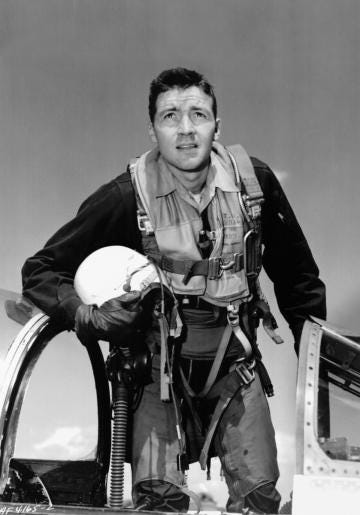OODA Loop: The fighter pilot technique for making instant decisions
From aerial combat to everyday decisions: how this 4-step loop works
🏷️ Categories: Mental models, Decision making and biases.
There’s a scene we’ve all experienced.
You’re standing in front of a shelf, looking at ten different types of pasta. Or maybe you’ve got a flight search open, five tabs, fifteen options… and the feeling that if you choose wrong, you’ll regret it.
In that moment, analysis paralysis takes over.
You know you have to decide, but too many options make it impossible to think clearly.
John Boyd, a U.S. Air Force colonel, knew something about this. Only in his case, indecision didn’t mean missing out on a cheap flight or buying pasta that wasn’t that tasty—it meant losing the lives of his soldiers.
From his need to decide quickly, precisely, and under pressure, the OODA Loop was born.
Today I want to tell you how it works, why it’s so effective, and how you can apply it to any decision in your life (from the most trivial to the most important) so you stop getting stuck in that moment of uncertainty.
Let’s go straight to the point...
1. What is the OODA Loop?
OODA stands for: Observe, Orient, Decide, and Act.
It’s a decision-making model designed for high-pressure situations.
It’s a living process, a 4-step loop that repeats over and over as the situation evolves (Ryder & Downs, 2022). The logic is simple: the faster and better you run through the cycle, the more advantage you’ll have over your opponent in combat.
In daily life, it means staying ahead of analysis paralysis.
John Boyd, its creator, was known as “Forty Second Boyd” because it was said he could win any dogfight in less than 40 seconds (Hillaker, 2015). That skill didn’t come from shooting first—it came from processing information and reacting faster than his adversary. Pulling the trigger is easy; knowing when and how isn’t.
That’s where the OODA Loop came from.
2. The Difference From Conventional Thinking
We usually think in terms of another cycle: PDCA—Plan, Do, Check, Act.
It’s a cycle of continuous improvement. It works… but it’s rigid.
PDCA is how we naturally tend to think. It forces you to commit early to a plan and then make adjustments later. OODA, on the other hand, allows you to commit late. You can adjust in real time, change direction if the context shifts, without getting trapped in “but this was the plan we had…”
In a world as fast-changing as ours, that flexibility is gold.
Knowing this technique gives you an edge: more mental tools to think better.
3. The Four Phases of the OODA Loop
1. Observe
When gathering data, we often fall into the collector’s fallacy—thinking that more data is always better. It’s not. Build the clearest possible picture of what’s happening by following three essential ideas:
Identify variables influencing the situation you’re analyzing: distinguish between primary and secondary ones.
If applicable, identify variables affecting the people involved: their interests, limitations, and motivations.
Anticipate sudden changes: list the most likely abrupt shifts in context so you can adapt before they happen.
A good observer perceives, selects, and prioritizes.
They can tell what adds value and what’s just noise.
Imagine a doctor in the ER: taking vital signs, listening to the patient, reviewing past tests to understand the context, evaluating body language… and instantly discarding irrelevant info for the current diagnosis.
That’s observation.
2. Orient
This is the most important phase.
Once you’ve gathered key information, you have to orient it to the case at hand. Data is never seen neutrally—it always depends on the lenses through which you see the world (Ryder & Downs, 2022).
Your culture, experiences, learning, problem-solving style—all bias you.
To illustrate orientation, Boyd used the metaphor of a “snowmobile”: taking components from different fields. Skis, a boat engine, a bicycle handlebar, tank treads—and assembling them into something new that works for your situation.
Notice this part: “that works for your situation.”
Orienting means examining information from multiple angles and assembling a useful vision for this moment. It’s about not having preconceived ideas of how things should be done, but adjusting to each situation based on what you observed.
In psychology, this is called cognitive flexibility.
3. Decide
Deciding means forming action hypotheses: “I believe this is the best option for now, for these reasons, and I’m going to test it” (Ryder & Downs, 2022).
Boyd stressed avoiding the first-conclusion bias: the tendency to cling to your first choice and ignore any information that contradicts it. The risk is becoming blind to signals that you should change course.
To decide well, do three things:
Define the initial action that best fits your observation and orientation.
Evaluate the acceptable level of risk: test it without fully committing all resources (time, money, energy) in case you need to pivot. How much could you lose, and how likely is that?
Use the technique of a planned retreat: define in advance the points or conditions where you’ll decide whether to continue, withdraw, or change direction, avoiding overcommitment.
Imagine a mountain rescue team: based on observation and orientation, they pick a route to reach the victim. They know the weather can change suddenly, so they prepare for that variable and already have a planned retreat with shelters marked in case of a storm.
Deciding in OODA is acting—with the door open to a quick correction.
4. Act
Acting means executing the decision and learning from the result (Ryder & Downs, 2022).
Action generates an immediate response: it confirms or corrects whether your observation and orientation were accurate. Without that experience, the cycle is incomplete. To act well: observe the consequences and extract lessons for the next loop.
Repeat the OODA Loop as many times as needed while the situation evolves.
You’re like a climber: after planning a route, placing the first anchor, and feeling how the rock responds, you move step by step, always attentive to instability.
That’s the OODA Loop.
4. How to Apply It in Daily Life
You don’t need to be in a fighter jet to use OODA.
This version I just presented is fully adapted for everyday situations we all face in business, personal projects, finances, and many other areas.
Some practical examples:
Planning a trip
Observe: compare prices, routes, dates.
Orient: filter what really matters (lower cost or fewer layovers?).
Decide: choose the best option that matches your priorities.
Act: buy the ticket before the price goes up.
Starting a newsletter project
Observe: research what topics interest your audience and which formats suit you and your readers.
Orient: define your unique style and focus (guides, analysis, practical advice, strong storytelling).
Decide: pick an initial set of topics and a realistic publishing frequency. As a planned retreat, if after 3 months you haven’t attracted new readers, adjust your outreach and revisit topics.
Act: publish the first issues, promote them on social media, and analyze which content sparks the most interaction.
Good decisions come from a methodical process, repeated many times, with an open mind and well-trained eyes. Use it and you’ll see the difference instantly.
Nothing more to add.
✍️ Your turn: How could you apply a faster OODA Loop in your work or personal life to gain an edge?
💭 Quote of the day: “He who can handle the quickest rate of change survives.” — John Boyd, New Conception of Air to Air Combat
See you next time! 👋







https://shepardscale.substack.com/p/john-boyd-was-not-your-productivity
https://substack.com/home/post/p-170203405